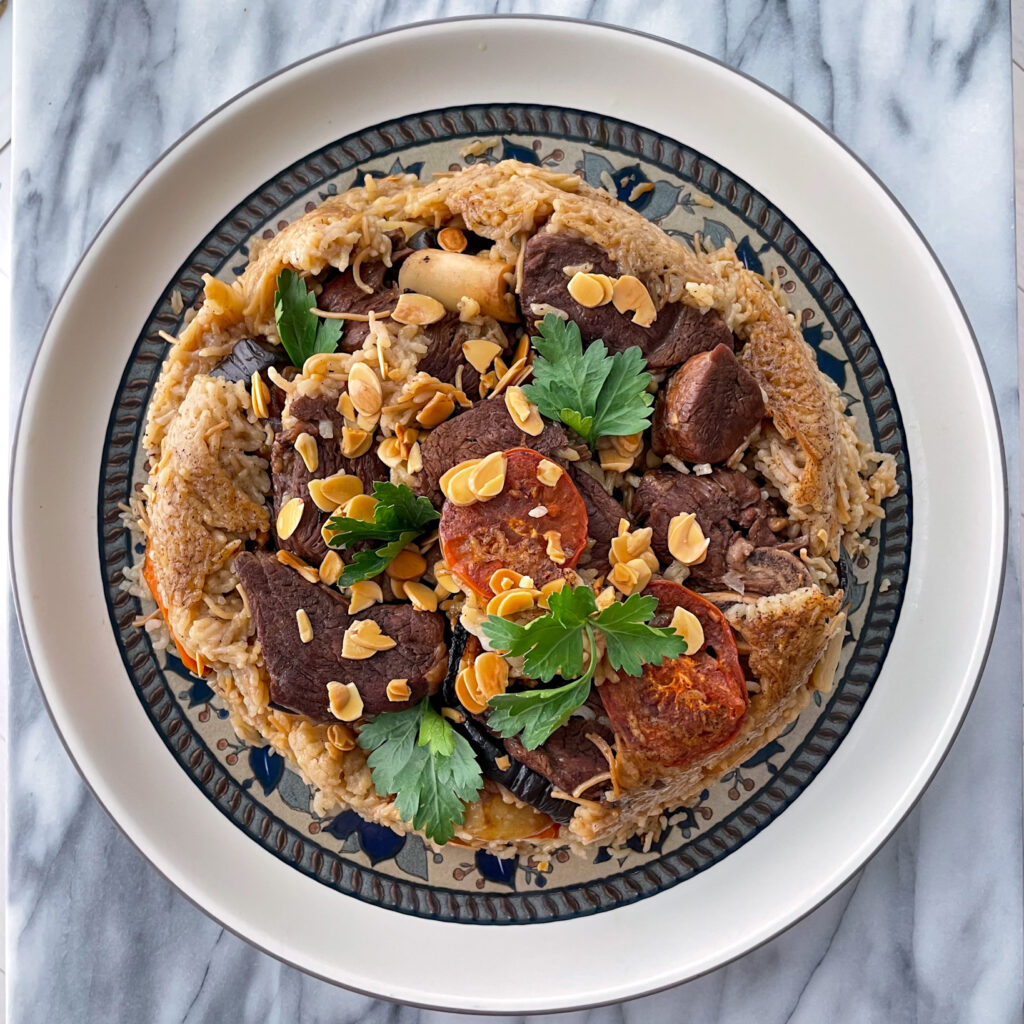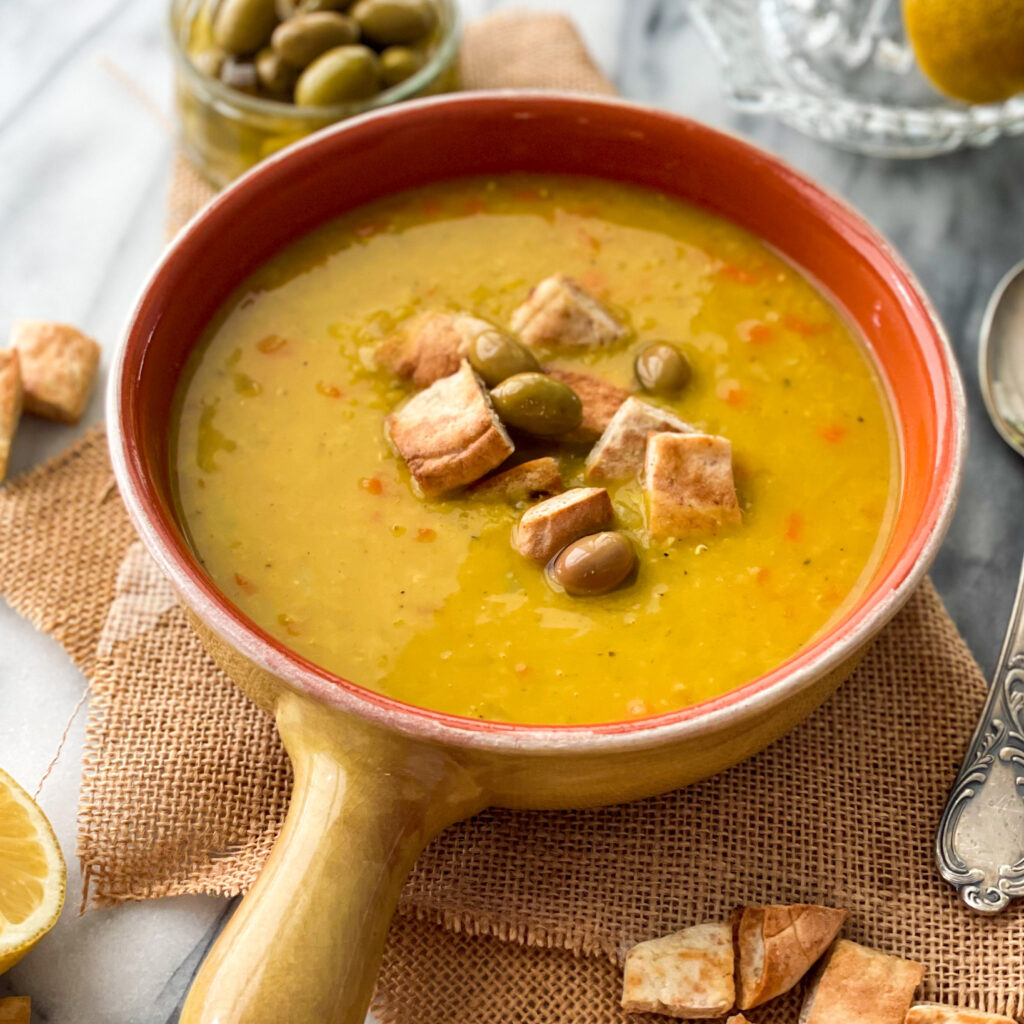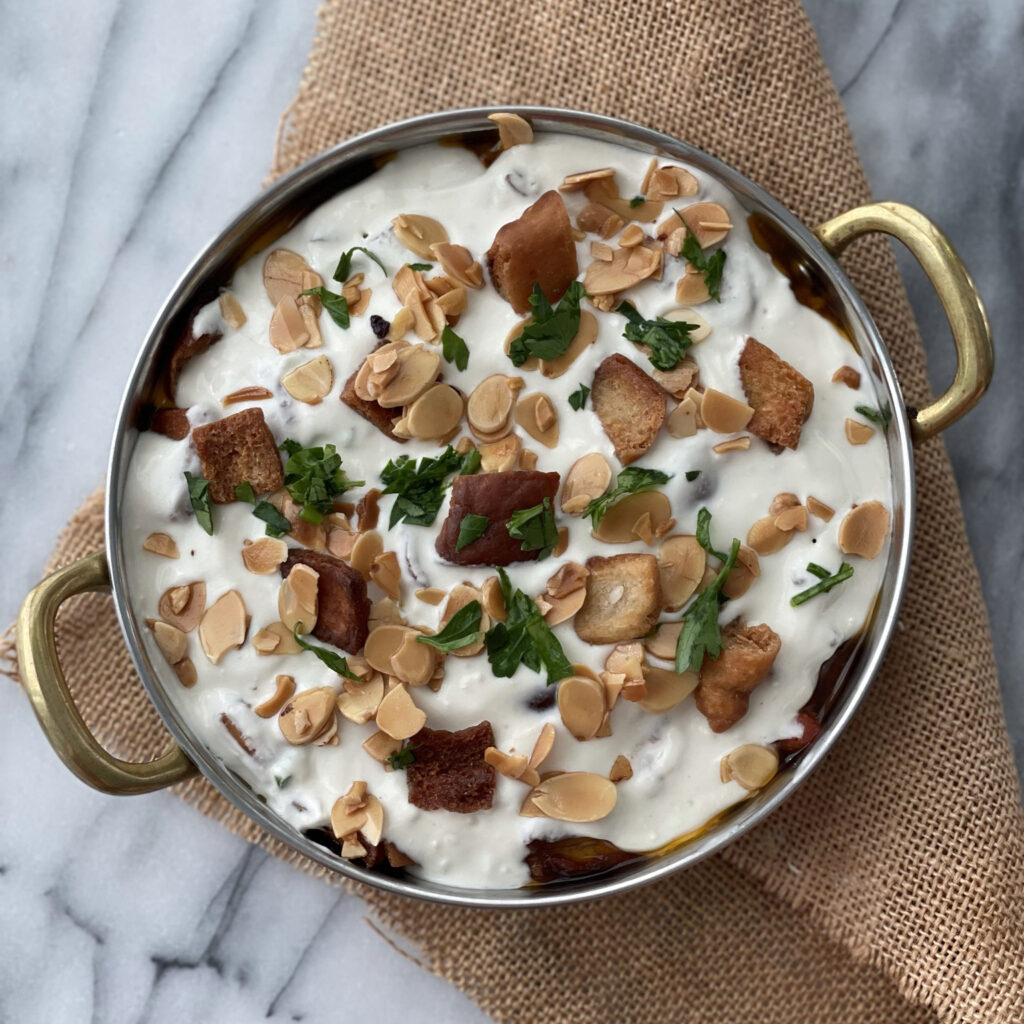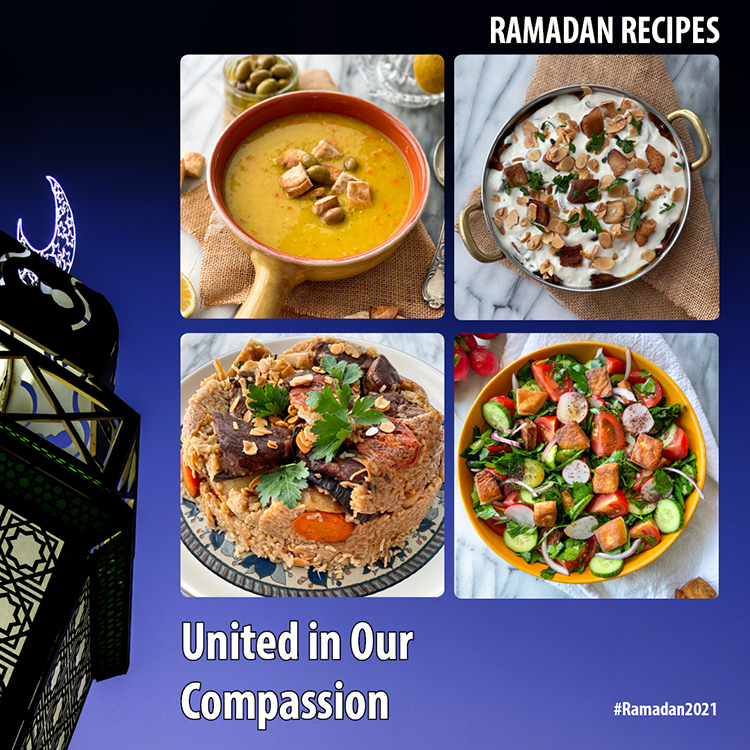Ramadan Weekly Recipe Collection 1
This week’s Ramadan Recipe Collection by food blogger Nida Khalaf features four delicious recipes, celebrating Palestinian culinary traditions and building connection through food.
MAQLOUBA
(RICE AND MEAT ONE-POT DISH)

Maqlouba (upside down) is a staple of the Palestinian kitchen. Maqlouba is most popular in the central region of Palestine and can be prepared in a variety of ways depending on the region in Palestine and the Levant. This one-pot dish consists of rice, meat (chicken or lamb), spices and vegetables. Maqlouba is a delicious dish full of fantastic & hearty flavors and is perfect for impressing a large group at an Iftar gathering.
The name Maqlouba translates to ‘upside down’, as the pot is turned upside down after cooking, giving the Maqlouba a lovely, layered look of rice, meats, and veggies.
Maqlouba is commonly made with either aubergine or cauliflower; however, in my family, we use both, so here’s my recipe!
Prep time: 30-45 mins
Enough for 3-4 people
Cook time: the meat (1.5 hrs), the veggies (20-30 mins), the Maqlouba (45mins)
Ingredients:
The meat: 800g of lamb pieces (preferably lamb shoulder)
– 3 tsp olive oil
– ¼ tsp nutmeg (or less)
– 1 tsp allspice pods
– 1 tsp black peppercorn pods
– 1.5 tsp 7 spices (if not available use all spice)
– 4-5 bay leaves
– 3 cardamom pods
– 2 pieces of cloves (do not use more as it has a robust flavor)
– 3 cloves of garlic
– ½ onion cut into large wedges
– ½ tsp salt
– 5 cups of water (1.5 Liter)
– 1 large tomato
– 1 carrot
– 2 medium potatoes
– 1 medium aubergine
– ½ a cauliflower head (medium size)
The rice:
– 2 cups rice
– 3 tsp vermicelli (sheer’ieh) + 1 tbsp olive oil
– 1 tsp salt
– ½ tsp 7 spice
Notes:
– For this dish, you need to use a large pot that is uniform in width (i.e., not wider from the bottom, and narrow from the top, not tapered).
– Start by preparing the meat, as the meat cooks, prepare the veggies. Once the meat is almost ready, prepare the rice and assemble.
Method:
Prepare the meat (prep time 5 mins, cooking time 1.5 hours):
– In a large pot, add the olive oil, and on medium-high brown the lamb pieces. This should take around 10 mins.
– Add the meat spices and flavorings and let them cook for additional few mins.
– Add the water and bring it to a boil. Use a spoon to scrape off any excess foamy fat that surfaces.
– Reduce the heat to medium-low and let the meat cook covered for 1.5 hours or until it becomes very tender. Once the meat is ready add ½ tsp of salt.
Prepare the veggies (prep time 5 mins, cooking 30 mins):
– Slice all the veggies into big circular pieces (except the tomato – it will be used later).
– Place the veggies on a baking tray covered with parchment paper. Add some salt, a drizzle of olive oil and bake at 400F for 30-40 mins.
Prepare the rice:
– In a pan, fry the vermicelli on medium high for 5 mins.
– Soak the rice in water for 30 mins and strain it. In a bowl, mix the uncooked rice with the cooked vermicelli, and add the spices.
Now let’s assemble the Maqlouba!
– Once the meat is cooked, using kitchen tongs, take out the lamb pieces. Use a strainer to drain the meat stock and set it aside. Save the stock for later.
– Slice the tomato into large circles and let’s start layering.
– Place the rice on the top of the veggies and spread it (it is ok if the veggies show or the rice falls).
– Pour the lamb stock over the rice just enough to cover it. On high heat, bring the Maqlouba to a boil for 10 mins uncovered. Reduce the heat to low, cover the pot, and let it cook for 45 mins or until the rice is done! Do not stir, touch, or remove the lid at this point.
– Once ready, let it sit for 5 – 10 mins, and flip it UPSIDE DOWN on a large serving place!
– For garnish, top it with pine nuts, almonds, and parsley.
– Enjoy with some plain yogurt, cucumber, mint, and yogurt salad, or Arabic salad.
ADAS MAJROUSH
(RED LENTIL SOUP)

This soup is delicious, quick, and comforting. Lentil soup is made with lentils, carrots, and potatoes, all of which are healthy vegan ingredients. Serve as a starter to whet one’s appetite before a filling Iftar dinner during Ramadan.
Prep 10 mins
Cook 45 mins
Enough for 3-4 people
Ingredients:
– 3 tbsp olive oil
– ¼ onion
– 1 clove of garlic
– 1 ¼ cups red lentil
– 1 medium-size carrot
– 1 medium-size potato
– ½ tsp turmeric
– ¾ tsp cumin (to taste)
– ½ tsp salt (to taste) and a sprinkle of black pepper
– 1 tsp lemon (to taste)
– 1.5-liter vegetable stock (you can use water, but vegetable stock is tastier)
Method:
– Finely chop all the veggies into tiny cubes.
– In a soup pot, add the olive oil, onion, and garlic; cook on medium heat for 5 mins until translucent and nice in color.
– Add the lentils, carrots, potatoes, and the seasoning and let them sweat for a few mins, occasionally stirring to prevent the veggies from sticking.
– Add the vegetable stock and bring it to a boil on high, then reduce the heat to medium-low, cover the pot, and let the soup cook for 45 minutes to an hour, or until it forms. Taste it to see if you want to add a little more salt or cumin.
– Squeeze in some lemon juice and serve the soup with pita bread and Palestinian olives!
FATOUSH SALAD

This refreshing salad has it all: its colorful, zesty and has a lovely texture thanks to the addition of fried pita bread (our version of the croutons). Fatoush combines the contrasting flavors of healthy ingredients with crispy radish, Sumac spice & Pomegranate molasses. Salads like Fattoush are very popular during Ramadan. A key ingredient in Fatoush is Baqleh (Purslane). I omitted it here as it is difficult to find in North America, but if you do find it add a handful to your salad. Some regions across the Levant add lettuce to this salad as well, so needless to say, you can experiment here, and here is my favorite recipe.
Prep – 10 mins
Portion for 2-3 people as an appetizer
Ingredients:
– 2 small cucumbers
– 2 cups roughly chopped parsley (not tightly pressed)
– 4 small tomatoes (I used cocktail tomatoes) or 2 medium size tomatoes (Sweet tomatoes are key to a tasty Fatoush salad)
– 5 leaves of mint
– 3 radishes
– ¼ medium-size red onion
– ¼ cup pita croutons
Salad dressing:
– 3 tbsp lemon juice
– 1.5 tbsp olive oil
– 1 tbsp pomegranate molasses
– 1.5 tbsp white vinegar
– ½ tsp sumac spice
– ¾ tsp salt (to taste)
Method:
– Cut ½ a loaf of pita bread into cubes, and shallow fry it in a pan using vegetable oil on medium-high until you get a nice golden color; this should take around 3-5 mins – if you prefer a healthier option, you can bake the pita.
– Roughly chop the parsley, cut the tomatoes into small wedges, slice the cucumber and radishes into small circles, slice the onion into half-moons, and finely chop the mint.
– In a small bowl, prepare the dressing by mixing all the ingredients. Place all the veggies in a salad bowl and pour ½ or ¾ of the dressing, thoroughly mix, add the croutons.
– Taste it to see if you want to add the rest of the dressing; if not, save it for later!
FATTET BEITENJAN
(AUBERGINE & PITA CROUTONS CASSERROLE)

Fattet Beitenjan is a Middle Eastern dish typically consisting of aubergine, meat, onions, garlic, and tomatoes. The secret to this recipe is the yogurt tahini topping that infuses the aubergine and meat with plenty of flavor and complexity.
Prep – 20 mins
Cook – Tomato sauce 10 mins, meat 10 mins, aubergine & pita 10 mins
Enough for 2-3 people as an appetizer
Ingredients:
The tomato sauce (qalayieh):
– 2 tbsp olive oil
– ¼ onion
– 2 cloves of garlic
– ½ Jalapeno pepper (optional)
– 2 – 3 medium-size ripe sweet tomatoes
– ¼ tsp salt and black pepper (to taste)
The meat:
– 2-3 tbsp olive oil
– 200 grams of minced beef (or a mix of minced beef and lamb)
– ½ tsp 7 spices (if not available use all spice)
– ¼ tsp salt
– 2 tbsp tomato sauce
The tahini and yogurt sauce:
– 2 tbsp tahini
– 1 cup yogurt
– Juice of ½ a lemon
– ¼ tsp salt
– 1 clove of minced garlic
– ¼ jalapeno pepper (optional)
– 3 cups aubergine cubes sprinkled with ½ tsp of salt
– 1 cup pita croutons
– ½ cup vegetable oil for frying
– ¼ cup boiled chickpeas (use the can ones)
– ¼ tsp dry coriander
– 1 tsp pomegranate molasses
– ¼ cup toasted almonds or pine nuts for garnish
Method:
Prepare the tomato sauce (qalayieh):
– Finely chop the onion, garlic, and tomato. In a pan, heat the olive oil on medium heat, then add the onion and garlic and cook until translucent this should take around 5 mins. Add the jalapeño towards the end.
– Once the onions are nice and slightly golden add the tomatoes, salt, pepper and let the tomatoes cook for around 10-15 mins. Set aside in the pan, we will be using it later!
Prepare the meat:
– In a pan, heat the olive oil on medium heat, add the onion and garlic and cook until translucent this should take around 5 mins.
– Add the meat and spices and let it cook for 10 mins, or until the meat is almost cooked.
– Add the tomato sauce and let it cook for another 2-3 mins.
Prepare the aubergine and pita:
– Cut the pita into small squares and slice the aubergine into medium size cubes.
– Use the vegetable oil and fry the pita in a pan until it is crunchy and golden in color 3-5 mins.
– Once done, in the same pan, fry the aubergine on medium-high until nice and golden in color.
– To absorb the excess oil, place the pita croutons and aubergine separately on plates covered with a paper towel.
Now let’s prepare the fatteh:
– Add the meat to the tomato sauce and cook for 2-3 mins on medium heat. Add the aubergine, boiled chickpeas, coriander, and pomegranate molasses and let them cook until they bubble for 2-3 mins. This mix should be sizzling hot!
– Now, using a casserole pan start assembling the fatteh:
Layer 1: the tomato, meat, aubergine sauce
Layer 2: fried pita croutons
Layer 3: the yogurt tahini sauce
Layer 4: toasted almonds
– Garnish with some parsley, a drizzle of pomegranate molasses, and pita croutons.
ABOUT NIDA KHALAF
Nida Khalaf was born and raised in Ramallah, Palestine. She later moved to North America to pursue higher education and settled in Toronto. For Nida, food, family, and culture are intimately tied up; food serves as a memory and a human connection. Preserving recipes passed down from her loved ones and sharing them with her own unique twist, gives her a wonderful sense of nostalgia for her childhood home and the people with whom she shared the cooking and dining experience. Follow Nida on Instagram!

